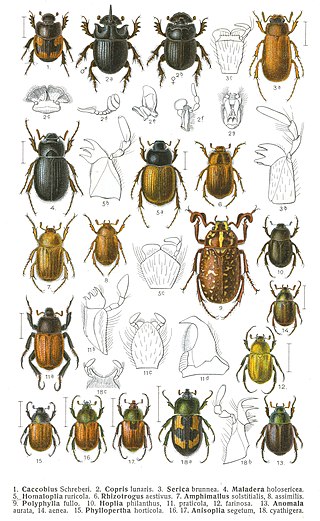
The family Scarabaeidae, as currently defined, consists of over 30,000 species of beetles worldwide; they are often called scarabs or scarab beetles. The classification of this family has undergone significant change in recent years. Several subfamilies have been elevated to family rank, and some reduced to lower ranks. The subfamilies listed in this article are in accordance with those in Bouchard (2011).

The bronzed cowbird, once known as the red-eyed cowbird, is a small icterid.
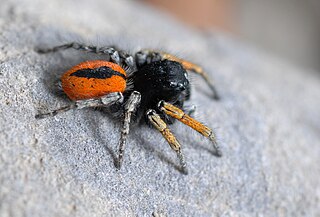
Philaeus chrysops is a species of jumping spider (Salticidae).

Ballus chalybeius is a jumping spider. It is the type species of the genus Ballus.

Cleridae are a family of beetles of the superfamily Cleroidea. They are commonly known as checkered beetles. The family Cleridae has a worldwide distribution, and a variety of habitats and feeding preferences.

Geotrupes stercorarius is a species of earth-boring dung beetle, common name Dor.

The bronzy hermit is a species of hummingbird in the family Trochilidae. It is found in Colombia, Costa Rica, Ecuador, Honduras, Nicaragua, and Panama.

The seepage salamander is a small, terrestrial species of salamander in the family Plethodontidae. It is endemic to the United States. They are found in small areas of Tennessee, North Carolina, Georgia, and Alabama. Its natural habitats are temperate forests, intermittent rivers, and freshwater springs. It gets its name from the seepages around which it lives. It is very similar in its appearance and life history to the pygmy salamander. These two species differ greatly from the other Desmognathus species. They are the smallest salamanders in the genus, measuring only 3–5 cm (1–2 in) in length. They are also the only two terrestrial, direct-developing Desmognathus species. However, the two species are not often seen to coexist, differing in distribution by elevation; although there are exceptions. The seepage salamander is currently listed as Near Threatened, with its numbers declining in most of states in which it is found. It is threatened by habitat loss, with logging having a major effect.
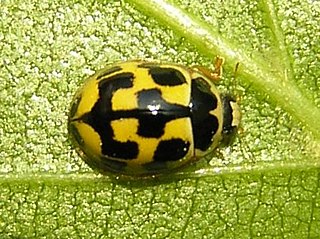
Propylea quatuordecimpunctata is a small lady beetle, belonging to the family Coccinellidae. It is sometimes referred to by the common name 14-spotted ladybird beetle, or simply P-14.

Selatosomus aeneus is a species of click beetle found in Europe. It was originally described as Corymbites aeneus by Carl Linnaeus.
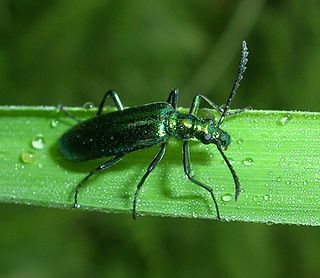
Prionoceridae is a small family of beetles, in the suborder Polyphaga. They form a group within the cleroid beetles and were formerly treated as a subfamily (Prionocerinae) within the family Melyridae. Very little is known of their life history but most species are pollen feeders as adults and occur in large numbers during spring or the host flowering season. Larvae are predatory or feed on decomposing wood.
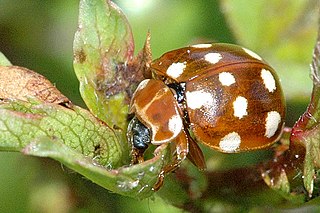
Calvia quatuordecimguttata, the cream-spot ladybird, is a species of ladybird in the family Coccinellidae. Its distribution is holarctic, it being found in Europe and through the East Palearctic to Japan. It is introduced to North America. This ladybird is generally 4 to 5 millimetres in length and varies in appearance depending on the geographical location. It usually lives in hedgerows and deciduous trees.

Zosimus aeneus, also known as the devil crab, toxic reef crab, and devil reef crab is a species of crab that lives on coral reefs in the Indo-Pacific from East Africa to Hawaii. It grows to a size of 60 mm × 90 mm and has distinctive patterns of brownish blotches on a paler background. It is potentially lethal due to the presence of the neurotoxins tetrodotoxin and saxitoxin in its flesh and shell.

Anotylus tetracarinatus is a small rove beetle with a wide distribution. It is the most common species of the genus, and maybe even of the family, in the whole of Central Europe.
Pollen beetle is an informal term for any species of beetle associated intimately with suitably pollen-rich species of flowers. Typically such a beetle is adapted to the pollen as a major part of its diet. Species in at least sixteen families of the order Coleoptera could be counted as pollen beetles, and "pollen beetle" also is a common name for some such species.

Typhaeus typhoeus, or the minotaur beetle, is a beetle in the family Geotrupidae, also referred to as earth-boring dung beetles. They are native to Europe. The beetle is named after the Typhon, a giant of Greek mythology.
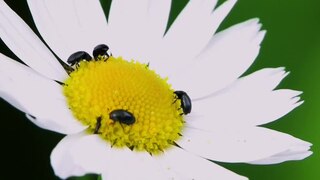
Brassicogethes aeneus, the common pollen beetle, is a species of pollen beetle in the family Nitidulidae. Other common names include the rape pollen beetle and rape blossom beetle. It was previously known as Meligethes aeneus.

Malachius aeneus, the scarlet malachite beetle, is a species of soft-winged flower beetle in the family Melyridae. The beetle was introduced to North America in 1852, and is now widespread. The larvae are frequently found near cereal crops and are known predators of Brassicogethes aeneus in Great Britain.
Ceratocanthus aeneus, known generally as the shining ball scarab beetle or round fungus beetle, is a species of pill scarab beetle in the family Hybosoridae. It is found in North America.
Notiophilus aeneus, also known as the brassy big-eyed beetle, is a species of ground beetle in the family Carabidae. It is found in North America. Approximately 5-6mm long, it is dark colored with a brassy tinge and large eyes. Adults are diurnally active in spring and summer.

















